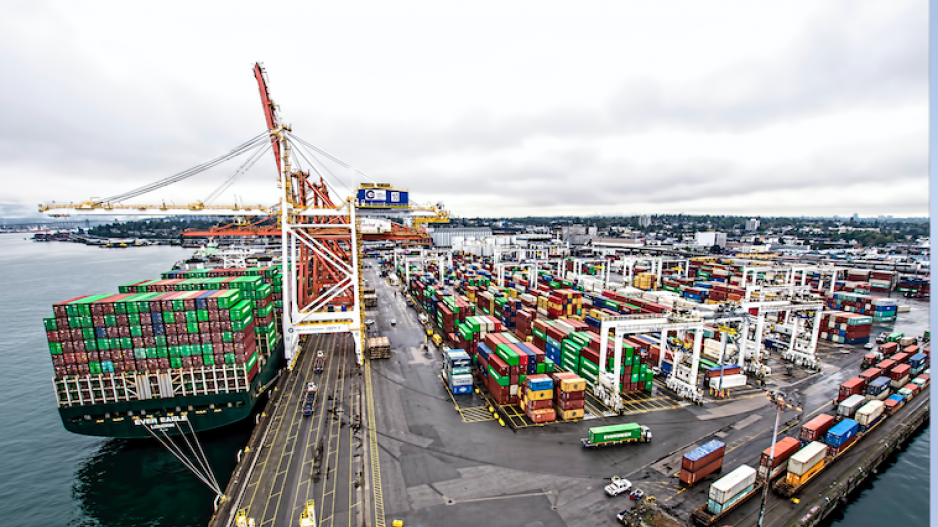The Port of Vancouver has begun testing the first 100 per cent renewable diesel vessel in its daily operations in hopes of accelerating progress toward its goal of becoming a net-zero emissions port by 2050.
The Vancouver Fraser Port Authority (VFPA) said that the Takaya, a patrol boat, has been undergoing testing since late summer and runs on renewable diesel – a fuel made from organic sources like vegetable oil and animal fats but retains the same chemical properties of fossil fuel-based diesel.
If successful, it means that vessels, trucks, train locomotives, cranes and other port infrastructure and assets that currently run on conventional diesel can be switched to this more sustainable fuel with little conversion costs.
“We need to see how these technologies and fuels are working,” said Ronan Chester, the VFPA’s director of climate action and sustainability leadership. “We need to put them in the hands of the operators. We don’t want to see a continuation forever of diesel engines. But there’s a lot of value built up in diesel assets that relate to the port, billions of dollars. That’s not all going to be converted to battery electric, hydrogen or some other kind of zero-emissions immediately. So in the meantime, this technology presents tremendous opportunity in a fuel that can reduce greenhouse gas emissions by roughly 80 per cent.”
The Takaya is the latest project in a multi-year initiative funded jointly with $1.5 million from each from the VFPA and the B.C. provincial government. Since 2019, the program has spearheaded trials such as Seaspan Ferries’ test of using biodiesel – or organically made diesel that requires special engines to run – on commercial ferry services between Vancouver Island and the Lower Mainland.
That test was such a success that all six of Seaspan’s commercial ferries operating on these routes now run on biodiesel.
Other efforts funded by the initiative include another six-month trial of a renewable diesel locomotive at Viterra’s Pacific Terminal grain facility, as well as the ongoing retrofitting of electric/hydrogen-fuel-cell gantry cranes and shore hydroelectric power for idling ships at DP World’s Centerm container terminal.
Battery-electric tractors have also been introduced at Seaspan’s Tilbury Marine Terminal on the Fraser River, officials confirmed.
All these step play into the VFPA’s support of Ottawa’s net-zero-emissions goal by 2050, a move that the Port of Vancouver aims to mirror by phasing out all port-related emissions by that same year.
“Charting our course towards a zero-emission port starts with collaborative efforts like these – between the port authority, the port community, and government – to test innovative new low-emission fuels and technologies that reduce emissions while keeping trade moving through the Port of Vancouver,” VFPA president and chief executive officer Robin Silvester said in a written statement.
The hope, Chester said, is for all the tests of low-emissions vehicles and vessels to be successful like the Seaspan Ferries program so that they can scale up in the next few years.
“We definitely want to see that happen,” he said, noting the port is working with BCIT on measuring emissions from these new changes. “These tests are about showing us that the technology works, and that it doesn’t create problems. If there are problems, we want to refine and respond to those.”
Chester added, however, that the long-term feasibility of renewable diesel at the Port of Vancouver will depend on creating enough of a business case for producers such as Shell, ExxonMobil and Parkland Corp. to see enough potential to scale up the fuel’s production. It then becomes a chicken-or-egg situation – but the key, Chester said, is taking these first steps towards a possible solution.
“I think that is the role of the port authority can play in this case,” he said. “That’s where we start to try to create greater understanding around potential demand scenarios ... [looking at] how do we facilitate the conversation with marine carriers, with the terminal operators, with the trucking industry to say, what could demand look like for higher renewable blends?
“And then, you can look at possible supply scenarios to fill that demand... and eventually, producers will have the capacity to create more in this market. Hopefully, that day isn’t too far away.”




